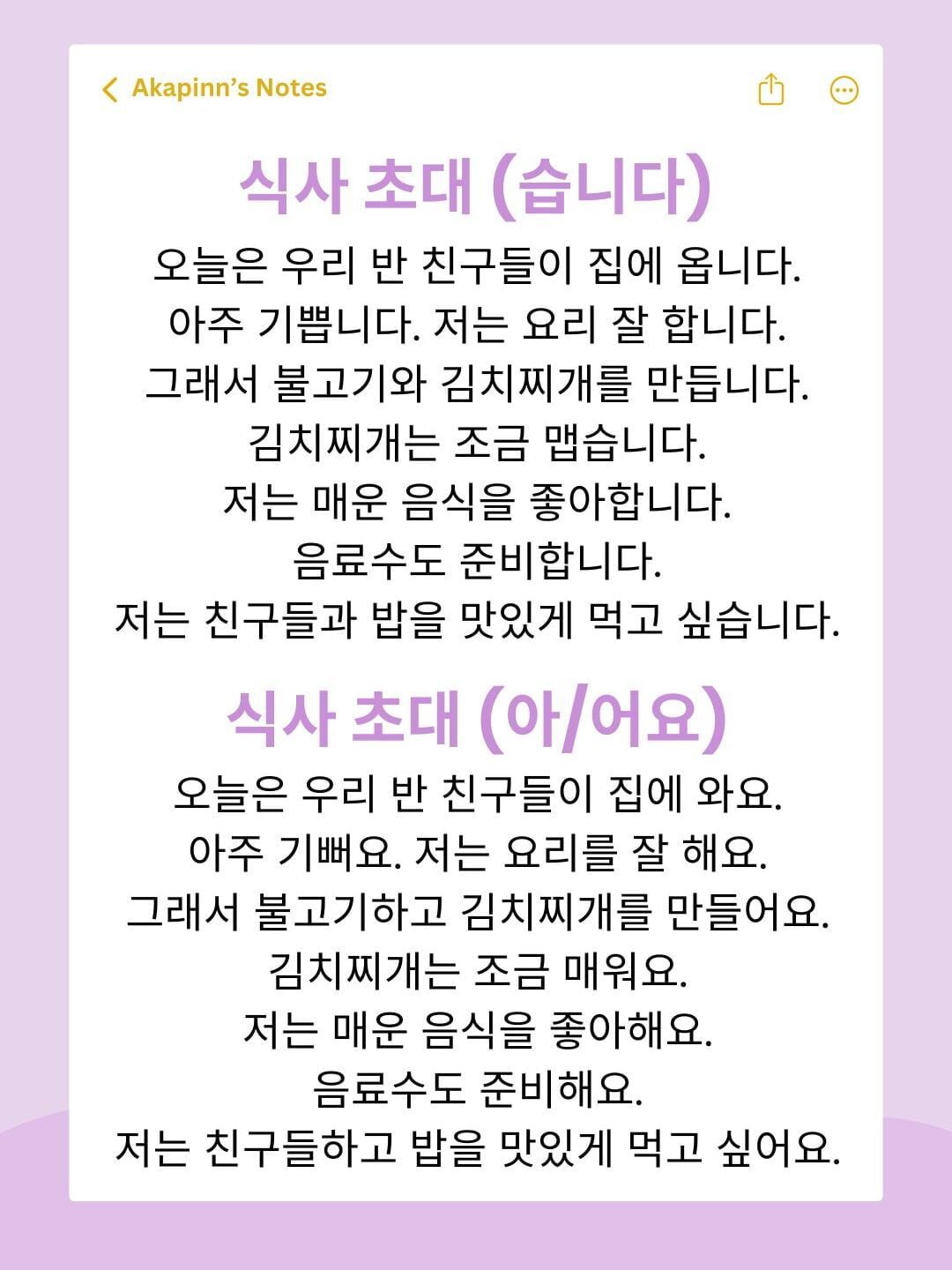여러분 안녕하세요 ! Hello there Korean learners 🙂 Today we’re studying a new short text to train your reading skills in Korean. It’s aimed at low beginners!
If you’re looking for something more challenging (but still aimed at beginners), check out this text about classmates, which is more complicated.
In this article, you will find :
- A short text or story written in Korean
- An audio file
- A translation of the text
- A vocabulary list
- A short explanation of the most difficult grammar parts if necessary
- A few questions to review your understanding of the text
Table of Contents
Korean Reading Practice

식사 초대 (습니다 form)
오늘은 우리 반 친구들이 집에 옵니다.
아주 기쁩니다.
저는 요리를 잘 합니다.
그래서 불고기와 김치찌개를 만듭니다.
김치찌개는 조금 맵습니다.
저는 매운 음식을 좋아합니다.
음료수도 준비합니다.
저는 친구들과 밥을 맛있게 먹고 싶습니다.
식사 초대 (아/어요 form)
오늘은 우리 반 친구들이 집에 와요.
아주 기뻐요.
저는 요리를 잘 해요.
그래서 불고기하고 김치찌개를 만들어요.
김치찌개는 조금 매워요.
저는 매운 음식을 좋아해요.
음료수도 준비해요.
저는 친구들하고 밥을 맛있게 먹고 싶어요.
Translation
Meal invitation
Today, my classmates are coming to my house.
I’m very happy.
I am good at cooking.
So, I’m making bulgogi and kimchijjigae.
Kimchijjigae is a little spicy.
I like spicy food.
I will also prepare beverages.
I want to eat well(deliciously) with my friends.

Vocabulary
| 한국어 | 영어 |
|---|---|
| 식사 | Meal |
| 초대 | Invitation |
| 반 친구 | Classmate |
| 기쁘다 | To be content / happy |
| 요리하다 | To cook |
| 만들다 | To make |
| 맵다 | To be spicy |
| 음식 | Dish |
| 좋아하다 | To like |
| 음료수 | Beverage |
| 준비하다 | To prepare / To get ready |
| 맛있다 | To be delicious |
| 먹다 | To eat |
Grammar points
-에
The particle -에 is used to indicate location or direction. It’s often translated as “at,” “in,” “on,” or “to” in English. This particle is essential for indicating where an action occurs or where something is located.
Examples:
학교에 – “at school”
집에 – “at home”
공원에 – “in the park”
-와 / 과
These particles mean “and” and are used to connect nouns.
-과 is attached to words ending in a consonant, -와 is attached to words ending in a vowel.
Examples :
사과와 바나나 – Apple and banana
빵과 우유 – Bread and milk
-게
-게 is used to turn adjectives into adverbs, expressing the manner in which an action is performed.
Examples :
맛있게 – deliciously
예쁘게 – beautifully
-고 싶다
This grammar construction is used to express the desire to do something. It’s attached to verbs to indicate the desire or wish to perform that action. You can only attach it to action verbs (example : 먹다) not adjectives (example : 맛있다).
Examples :
먹고 싶다 – I want to eat
가고 싶다 – I want to go
보고 싶다 – I want to see
Questions : About the Text
(1) Choose the correct answer
① 어제 친구를 초대했습니다.
② 내일 친구를 초대할 겁니다.
③ 오늘 친구를 초대합니다.
④ 친구가 없습니다.
(2) True or false ?
① 김치찌개는 안 맵니다.
② 김치찌개와 불고기를 만듭니다.
③ 음료수를 준비합니다.
④ 저는 요리를 잘 못 합니다.
Answers
First question :
③ 오늘 친구를 초대합니다.
Second question :
① 김치찌개는 안 맵니다. => False
② 김치찌개와 불고기를 만듭니다. => True
③ 음료수를 준비합니다. => True
④ 저는 요리를 잘 못 합니다. => False
Study Method for Texts
If you’re not familiar with text study, here’s a method I would suggest you try.
To study this text, start by reading it from beginning to end once without paying too much attention to whether you understand fully or not. Then, listen to the audio file (if there is one) and read along.
You can press pause as many times as needed.
During your second read, try to understand as much as possible. If you can’t understand some of the words, check their meaning as well.
When you finish your second read, ensure you understood the story/text correctly. Read a third time (with or without audio). It’s even better if you read it out loud: it will improve your speech fluency over time.
You can then try answering the questions asked at the end!





Hello,i Hope you will see this. I am a very beginner in Korean and i wanted you to please explain the meaning of the 하고 attached to 불고기 for the 아/어요 form
Hello! thank you for your question, it’s a good one!
-하고 is the same as -와/과 (that you can see in the 습니다 form) : it means “and”.
The difference is that -와/과 is used for more formal situations (as well as written text). -하고 is more casual than -와/과.